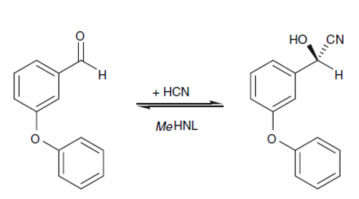Oxynitrilases (HNL)

| Enzymes | Product Code | Specification |
| Enzyme Powder | ES-HNL-101~ ES-HNL-129 | a set of 29 oxynitrilases, 50 mg each 29 items * 50mg / item, or other quantity |
| Screening Kit (SynKit) | ES-HNL-1800 | a set of 18 (S)-oxynitrilases, 1 mg each 18 items * 1mg / item |
| Screening Kit (SynKit) | ES-HNL-1100 | a set of 11 (R)-oxynitrilases, 1 mg each 11items * 1mg / item |
★ High substrate specificity.
★ Strong chiral selectivity.
★ High conversion.
★ Less by-products.
★ Mild reaction conditions.
★ Environmentally friendly.
➢ Normally, the reaction system should include substrate (aldehydes / ketones, HCN), buffer solution (optimum reaction pH) and the enzymes.
➢ All the ES-HNLs can be tested respectively in the reaction system above or with the HNL Screening Kit (SynKit HNL).
➢ All kinds of ES-HNLs corresponding to various optimum reaction conditions should be studied individually.
➢ High concentration Substrate or product with may inhibit ES-HNL’s activity. However, the inhibition can be relieved by batch addition of substrate.
Example 1 (1):

Keep 2 years below -20℃.
Never contact with extreme conditions such as: high temperature, high/low pH and high concentration organic solvent.
1 Langermann J, Guterl JK, Pohl M, e tal. Bioprocess Biosyst Eng, 2008, 31: 155-161.









